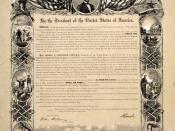The bell curve of African American rights has risen and fallen throughout America's history. The period between the Pre-Civil War Era and the Post Civil War Era, were momentous in displaying the status and rights of African-Americans in the time. As the Civil War approached, the status of African-Americans was an increasingly troubling issue among the American Public. During the War, the bell's curve had reached its height. And during the Post-Civil War, the curve fell slowly and would not rise again for another 100 years. The cause of this racial bell curve is a series of political and social events that directly affected the lives of African Americans.
The Compromise of 1850 marked the initial rise of Black loss of rights in this period. Previously, it was possible for Northerners to ferry slaves to their freedom. However, "Included in the compromise were funds budgeted specifically for catching fugitive slaves and prosecuting anyone lending assistance in the effort" (Kevin Holloway, The Fugitive Slave Act and the Compromise of 1850).
With specific funds that were directed in catching fugitive slaves, white bounty hunters could freely raid the North and search for fugitive slaves. These brutal hunters could now abduct any Black person left alone. Many Blacks that were never in bondage were kidnapped and taken to the South to be slaves. This legislation limited the rights of African Americans and enabled the white populous to oppress African Americans.
The bell curve approached its peak when the novel Uncle Tom's Cabin was introduced to American Culture. This novel, by Harriet Beecher Stowe, was a revelation to the North because it displayed the cruelty of the southern trade practice. This single piece of literature created uproar throughout the country. The North was outraged by its tale of tragedy, deceit and hate.


